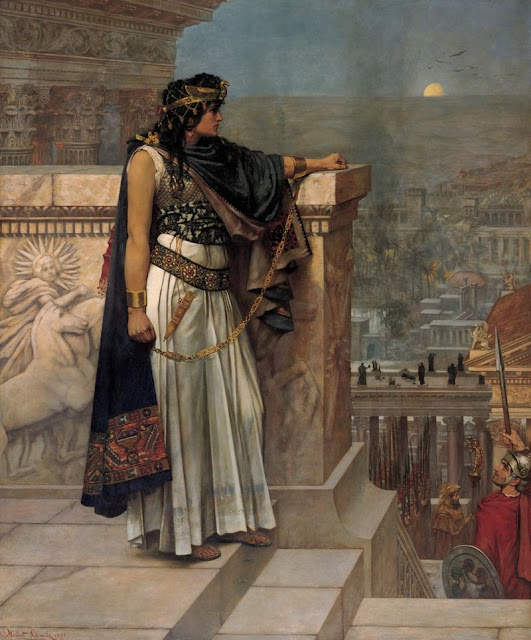A history resource article by Mary Harrsch © 2007
 |
| Queen Zenobia's Last Look Upon Palmyra, by Herbert Gustave Schmalz Image courtesy of Wikimedia Commons |
"History is a mirror of the future," says Oussama Rahbani. "If you don't have a history, you don't have a future." It was with this notion of embracing the past in order to greet the future that Lebanese composer Mansour Rahbani, in collaboration with his sons Marwan, Oussama, and Ghady Rahbani, created the epic musical "Zenobia," which opened a five-night run on Wednesday evening for the Byblos International Festival, in the old port city north of Beirut.
Though in many ways a tragedy, ending in defeat and suicide, the play is at heart a celebration - of culture, music and freedom, and, perhaps more forcefully, of the strength, determination and ferocity of the female spirit.
What makes "Zenobia" enveloping and believable is the plot's adherence to the play's historical foundation. Zenobia was the third-century queen of Palmyra, an oasis in the desert of central Syria fueled by caravans snaking along the Silk Road. Sandwiched between the two great powers of the day, the Persians to the east and the Romans to the west, the city was caught between two empires jockeying for position. Palmyra became a Roman province in the first century.
 |
| A head said to represent Odenathus in the Palmyra Museum. Image courtesy of Wikimedia Commons. |
When her husband Odenathus was murdered along with his heir, Zenobia, ruling in the stead of her young son Vaballathus, rebelled against Rome. She was eventually defeated and hauled off to answer for her defiance but not before liberating greater Syria, Palestine and parts of Egypt.
With this historic episode as a reference, the Rahbanis succeed in fabricating a performance of savory meaning and depth. This is not to say that they do it alone - close to 100 actors and actresses took the stage on Wednesday night, with a supporting army of technicians, designers, choreographers and assistants - but the creative energy behind the production is exemplary of the quality of theater Lebanese audiences have come to expect from a Rahbani production.
The play opens with a dream sequence in which Zenobia, played by Carole Samaha, receives a prophecy from Cleopatra that she will be ruler of the East. In reality Cleopatra was Zenobia's idol - she even claimed to have descended from her as Zenobia's mother hailed from Egypt. But in the play, Cleopatra takes on the additional role of Zenobia's subconscious, mentor and, at times, tormentor.
Odenathus, the king of Palmyra, returns with the army from a victorious battle against the Persians. While Zenobia asserts that the victory belongs to Palmyra and not Rome, her counselor Longinus - modeled after the queen's real-life advisor, the philosopher and rhetorician Cassius Dionysius Longinus - tries to convince her to break away from Rome. Zenobia is reluctant to cut the alliance, even though she remains intensely tethered to the East.
This state of affairs does not last long, however. Odenathus travels to Emesa (modern day Homs in Syria) against the advice of Zabdai (played by Ghassan Saliba), the leader of Palmyra's army. There the king is betrayed by his nephew Ismail Maeonus, who, after killing Odenathus and his son, declares himself "the king of kings."
Zenobia, who now fears that her city will be trampled underfoot by the Persians and Romans alike, takes charge and vows to extend her territory into Asia Minor and up to the gates of Rome itself."
More about Zenobia:
A Kindle preview:
More suggested reading:
 |
 |
 |




